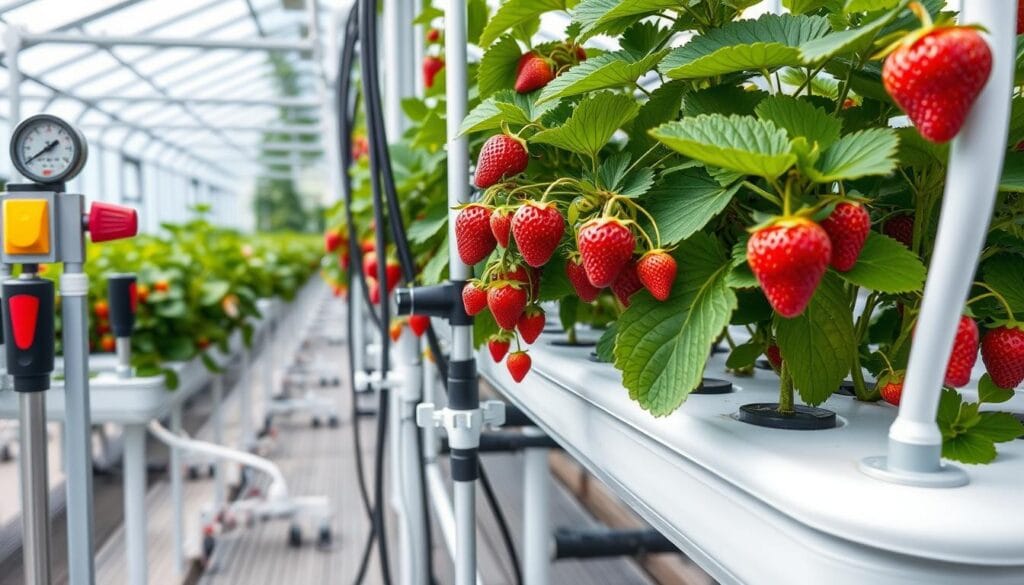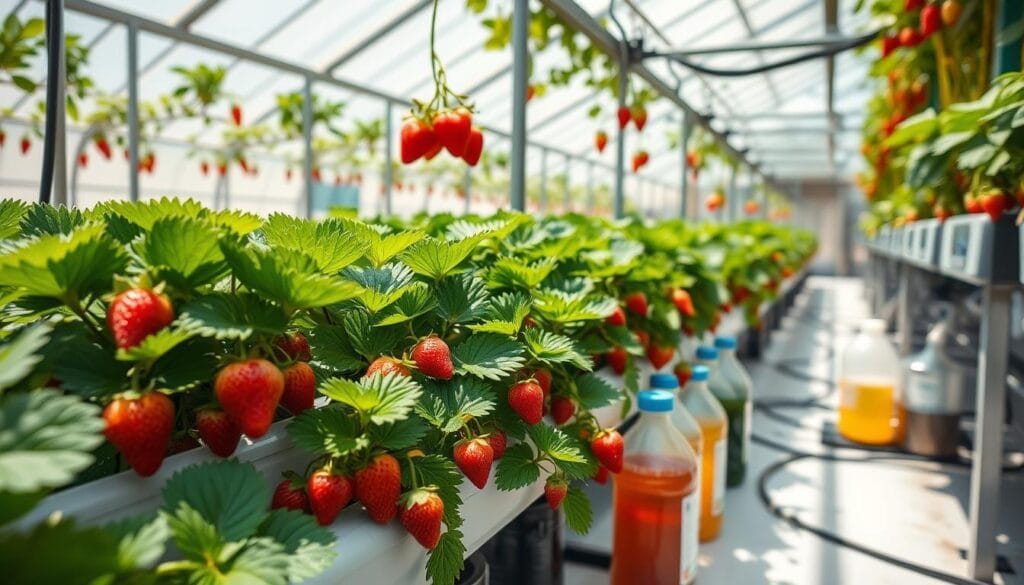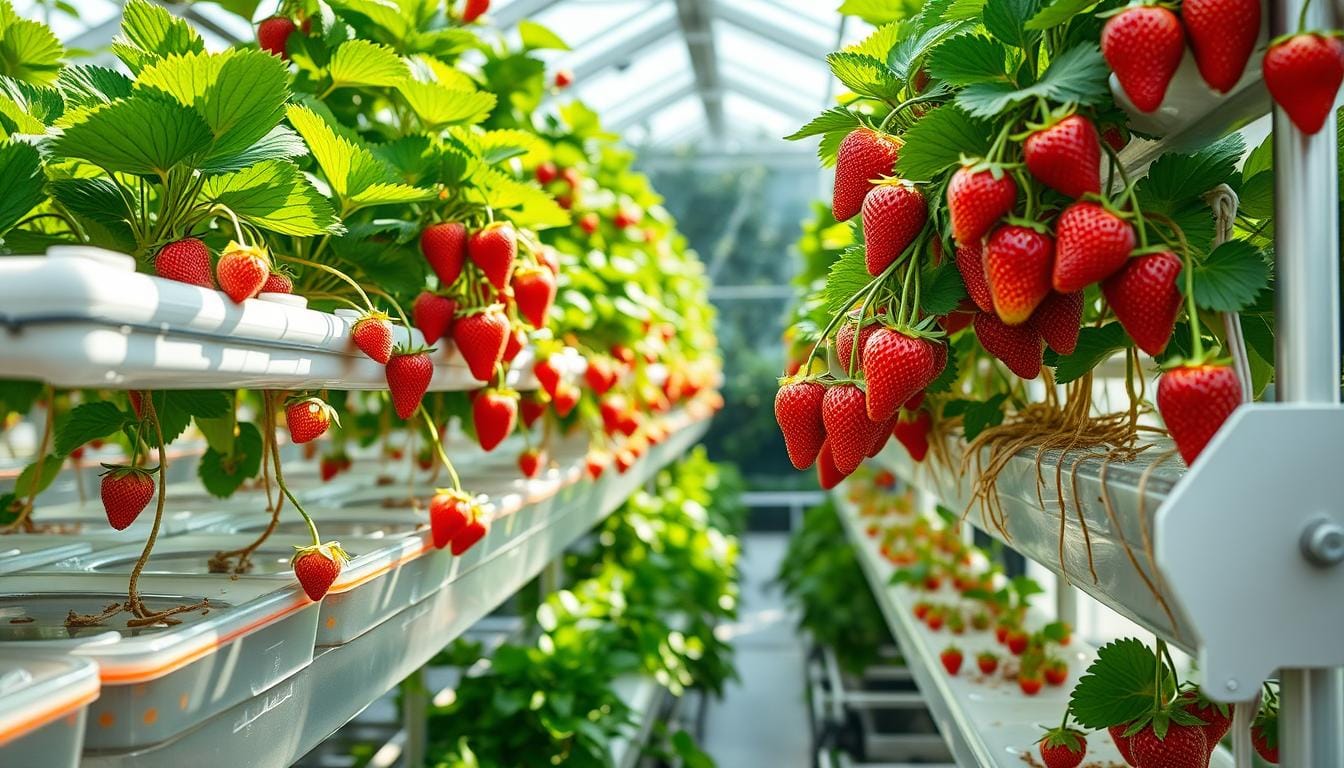“Hydroponic System for Delicious Strawberries” offers an easy way to grow sweet, juicy strawberries all year round. With a hydroponic system for delicious strawberries, you can enjoy fresh berries indoors, regardless of the weather outside. I used to struggle with traditional gardening, but hydroponics transformed my approach, making it possible to grow these tasty strawberries all year long.
Imagine picking ripe strawberries from your kitchen or basement. They’re free from pesticides and soil diseases. A hydroponic system for strawberries is more than gardening. It’s a way to grow fresh, sustainable produce.
Key Takeaways
- Hydroponic systems reduce water consumption by up to 90%
- Year-round strawberry production is possible.
- Eliminates soil-borne diseases and pesticide use
- Enables precise control of growing conditions
- Increases crop yield compared to traditional farming
Understanding Hydroponic Strawberry Cultivation Basics
Hydroponic strawberry cultivation is a new way to grow tasty fruits. It uses controlled environment agriculture. This method gets rid of soil and delivers nutrients directly to the roots.
Hydroponic systems have changed sustainable horticulture a lot. They give gardeners and farmers more control over growing plants.
What Makes Hydroponics Different from Traditional Growing
Hydroponic systems stand out in several ways:
- Direct nutrient access for plants
- Water conservation (up to 90% less water usage)
- Elimination of soil-related plant diseases
- Year-round growing capabilities
Benefits of Soilless Strawberry Production
Growing strawberries hydroponically has many benefits:
- Faster plant growth rates
- Higher crop yields
- Enhanced nutrient-rich solution control
- Reduced pest and disease risks
Essential Components of Hydroponic Systems
A good hydroponic strawberry setup needs a few key parts:
- Nutrient solution reservoir
- Growing medium
- Precise pH monitoring equipment
- Lighting systems
- Temperature and humidity controls
“Hydroponics transforms agriculture by giving plants exactly what they need when they need it.” – Modern Farming Expert.
Using these new growing methods, you can grow strawberries that are top quality. You can do this no matter what the weather is like outside.
Key Benefits of Growing Strawberries Hydroponically
Vertical farming has changed strawberry growing, giving gardeners and farmers big wins. Hydroponic strawberry systems are a top-notch way to grow tasty, healthy fruits efficiently.
With hydroponics, you can grow more strawberries than ever before. These systems bring many key benefits:
- Year-round fruit production, no matter the season
- Up to 98% less water use than traditional farming
- Control over growing conditions
- Healthier plants and less disease
- More space for growing in cities and small areas
Hydroponic strawberry growing lets you feed plants nutrients right to their roots. This way, you can create perfect growing conditions for amazing growth.
“Hydroponics transforms strawberry cultivation from a seasonal challenge into a year-round opportunity.” – Agricultural Innovation Expert.
| Growing Parameter | Optimal Hydroponic Conditions |
|---|---|
| Temperature Range | 65-75°F (daytime), 50-55°F (nighttime) |
| Light Exposure | 14-16 hours daily |
| Nutrient Solution pH | 5.5-6.5 |
| Humidity Level | Above 60% |
Starting your hydroponic strawberry journey means more than just high yields. You’ll also get nutritionally superior fruits. These strawberries are packed with vitamins, antioxidants, and exceptional flavor.
Hydroponic System for Delicious Strawberries: Popular Options
Choosing the right hydroponic system can make growing strawberries indoors a breeze. Each system has its perks for growing healthy strawberries.
Deep Water Culture (DWC) Systems
Deep Water Culture is great for growing tasty strawberries. It keeps roots in water full of nutrients, perfect for growth.
- Roots get constant oxygen and nutrients
- Easy to set up for beginners
- High strawberry yields
Nutrient Film Technique (NFT)
NFT systems give roots a steady flow of nutrients and oxygen. This keeps strawberries healthy and strong.
- Exact nutrient delivery
- Uses less water
- Works well in different spaces
Drip Systems and Their Advantages
Drip systems send nutrients right to the roots. This boosts plant health and efficiency.
| System Feature | Benefit |
|---|---|
| Controlled Nutrient Delivery | Reduces waste, optimizes plant growth |
| Flexible Design | Adaptable to various growing spaces |
| Water Conservation | Uses up to 90% less water than traditional farming |
“Choosing the right hydroponic system can dramatically improve strawberry production and quality.” – Hydroponic Farming Expert
Each hydroponic system has its benefits for growing delicious strawberries. Your choice depends on your space, budget, and experience.
Selecting the Perfect Strawberry Varieties for Hydroponics
Choosing the right strawberry varieties is key for growing strawberries well in indoor systems. Not all strawberries do well in hydroponics. Knowing what varieties work best is important for a big harvest.
When picking strawberry varieties for hydroponics, look at these main types:
- Day-Neutral Varieties: Great for steady strawberry growth indoors
- Seascape
- Albion
- Tribute
- Tristar
- June-Bearing Varieties: Perfect for one big harvest
- Honeoye
- Chandler
- Sequoia
Growers should focus on varieties with certain traits:
- Strong disease resistance
- Continuous fruiting
- Compact growth
- High fruit quality
“The right strawberry variety can increase your hydroponic yield by up to 30%” – Hydroponic Farming Expert
Studies show Albion and Chandler do well in hydroponics. They adapt well, produce fruit consistently, and taste great. These traits are perfect for growing indoors.
Essential Equipment and Setup Requirements
Starting a controlled environment agriculture project means picking the right tools for growing strawberries indoors. You need to choose carefully to ensure your plants grow well and produce a lot.
To turn your indoor space into a strawberry farm, you need to invest in the right equipment. Here are the key items you’ll need to create a perfect growing space:
Lighting Solutions for Indoor Growth
Light is very important for growing strawberries indoors. LED grow lights give the right light and intensity for strong plant growth. Here are some lighting tips:
- Full-spectrum LED grow lights
- 12-16 hours of daily light exposure
- Light intensity between 400-600 μmol/m²/s
Temperature Control Systems
Keeping the environment stable is key for growing strawberries in a hydroponic system. Your temperature control system should:
- Maintain temperatures between 65-75°F (18-24°C)
- Include digital thermostats for precise regulation
- Provide heating and cooling capabilities
Water and Nutrient Management Tools
Managing water and nutrients is important for healthy strawberry growth. You’ll need:
- pH testing meters
- Electronic conductivity measuring devices
- Automated nutrient dosing systems
“The right equipment transforms hydroponic strawberry cultivation from a challenge to an art form.” – Hydroponic Growing Expert.
Investing in good equipment is key to success in growing strawberries indoors. Each piece works together to create the best environment for your plants to thrive.
Nutrient Solution Management and pH Balance

Creating a nutrient-rich solution is key to growing hydroponic strawberries well. Your hydroponic system needs precise nutrient management for strong plant growth and tasty fruit. Understanding the balance of minerals and pH levels is the first step in sustainable horticulture.
For optimal nutrient solution, consider these key elements:
- Macronutrients: Nitrogen, phosphorus, and potassium
- Micronutrients: Calcium, magnesium, and sulfur
- Recommended N-P-K ratio of 1:1:2 for strawberry development
pH levels are vital for nutrient absorption. Maintaining a pH between 5.5 and 6.5 ensures maximum nutrient uptake. Regular monitoring and adjustment are essential for healthy plant growth.
“In hydroponics, precision is the key to exceptional strawberry production.” – Hydroponic Farming Expert
Your nutrient management strategy should include:
- Weekly solution testing
- Consistent nutrient concentration checks
- Periodic solution replacement
- Careful electrical conductivity (EC) monitoring
By following these sustainable horticulture practices, you’ll create the best environment for your hydroponic strawberries. This ensures bountiful and flavorful harvests all year round.
Environmental Control for Optimal Growth
For hydroponic strawberries to grow well, you need to manage the environment carefully. Your vertical farm will do great if you control important factors. These factors affect plant health and how much fruit they produce.
Light Cycle Management
Strawberry plants need the right amount of light to grow well. Follow these important lighting tips:
- Give them 12-16 hours of light every day.
- Ensure your LED grow lights deliver at least 40 watts per square foot to optimize growth and productivity.
- Keep the light intensity steady to mimic natural daylight.
Temperature and Humidity Control
Keeping the right temperature and humidity is key for hydroponic strawberries. Aim for these ranges:
- Temperature: 65-75°F (18-24°C)
- Humidity: 60-70%
- Use climate control systems for steady conditions.
Air Circulation Requirements
Good air movement stops disease and helps plants grow. Use these ventilation tips:
- Use oscillating fans for gentle airflow.
- Make sure air moves well to avoid moisture buildup.
- Keep air moving without stressing the plants with strong winds.
“Environmental control is the cornerstone of successful hydroponic strawberry cultivation.” – Vertical Farming Expert.
Mastering these environmental control methods will help you create the perfect place for your strawberries. This will make sure your plants are healthy and produce lots of fruit in your controlled environment.
Common Challenges and Solutions in Hydroponic Strawberry Growing
Growing strawberries indoors comes with its own set of challenges. It’s important to manage these carefully and use smart strategies. This helps keep your hydroponic strawberry system healthy and prevents problems.
Environmental control and nutrient management are big challenges in growing strawberries hydroponically. Knowing these issues helps you build a strong growing space.
- Nutrient Solution Management
- Maintain pH levels between 5.5 and 6.5
- Test electrical conductivity (EC) weekly
- Use high-quality hydroponic nutrients
- Pest and Disease Prevention
- Implement integrated pest management
- Regularly inspect plant roots
- Use biological control methods
“Achieving success in hydroponic strawberry cultivation is rooted in prevention, rather than solely relying on treatment.” – Hydroponic Farming Expert
Keeping the environment right is key in growing strawberries indoors. Keeping the temperature between 60-80°F and humidity at 60-70% helps a lot. It reduces stress and disease risks.
| Challenge | Solution | Prevention Strategy |
|---|---|---|
| Root Rot | Improve oxygen levels | Use air stones, maintain clean systems |
| Nutrient Deficiencies | Balanced nutrient solution | Regular monitoring and adjustment |
| Temperature Fluctuations | Consistent climate control | LED grow lights, proper ventilation |
By tackling these common problems, you can make a great indoor strawberry growing space. This space will produce delicious strawberries all year round.
Maintenance Schedule and Best Practices
To keep your hydroponic system for strawberries thriving, you need a solid plan. Your care for the plants will affect their health and how much they grow. A good maintenance routine helps your strawberries grow well and produce more.

Keeping your hydroponic system in top shape involves three main steps: daily, weekly, and monthly checks. Each step is important for a healthy strawberry garden.
Daily Monitoring Tasks
- Check water levels in the reservoir
- Monitor pH levels (ideal range 5.5-6.5)
- Inspect plant health for early signs of stress or disease
- Verify temperature and humidity conditions
Weekly Maintenance Requirements
For your weekly tasks, focus on more detailed system care:
- Replace nutrient solution
- Prune strawberry plants
- Conduct thorough pest and disease inspections
- Clean growing surfaces and equipment
Monthly System Checks
Monthly checks help keep your system running smoothly and your plants healthy:
| Task | Purpose |
|---|---|
| Deep system cleaning | Prevent algae and bacterial growth |
| Equipment calibration | Ensure accurate monitoring tools |
| Comprehensive nutrient analysis | Optimize plant nutrition |
“Consistent maintenance is crucial to maintaining the sustainability and productivity of hydroponic strawberry farming.”
By sticking to these maintenance steps, you’ll make a great place for growing hydroponic strawberries. Your hard work will lead to healthier plants, more strawberries, and more delicious strawberries.
Harvesting and Post-Harvest Handling Tips
Learning to harvest strawberries is key for growing them well indoors. You need to watch them closely and handle them gently. This keeps their taste and quality top-notch.
- Fully red color covering the entire berry surface
- Slight softness when gently touched
- Uniform ripeness across the fruit
- Typical harvest window: 4-6 weeks after planting
How you pick strawberries can affect their quality. Follow these steps:
- Use sharp, clean scissors or a small knife
- Cut berries with a short stem attached
- Hold the berry gently to prevent bruising
- Harvest in the morning when temperatures are cooler
“Continuous maintenance is crucial for safeguarding the long-term viability and optimizing the productivity of hydroponic strawberry farming.”
After picking, it’s important to take good care of your strawberries. Here’s how:
| Action | Purpose | Timing |
|---|---|---|
| Immediate Cooling | Preserve freshness | Within 30 minutes of harvest |
| Gentle Cleaning | Remove debris | Just before consumption |
| Proper Storage | Extend shelf life | Refrigerate at 32-36°F |
Pro tip: Handle your hydroponic strawberries like delicate treasures to maximize their flavor and presentation.
Maximizing Yield Through Advanced Techniques
To get the most out of growing strawberries, you need to learn advanced vertical farming methods. These new ways can greatly boost your strawberry harvest.
Vertical growing systems are great for making the most of your space. They let you grow more plants in a smaller area. This turns your growing space into a high-productivity strawberry farm.
“Advancements in vertical farming have the potential to boost crop yields by as much as 300% compared to conventional farming methods.”
Here are some key ways to increase strawberry yields:
- CO2 enrichment to boost photosynthesis efficiency
- Precision fertigation for targeted nutrient delivery
- Specialized light spectrum optimization
- Advanced environmental control systems
Here are some important strategies for growing more strawberries:
- Implement multi-level vertical growing systems
- Use LED grow lights for energy-efficient illumination
- Develop automated monitoring platforms
- Experiment with nutrient formulations
Aeroponic techniques can change how you grow strawberries. They use up to 95% less water. Plants get the right amount of oxygen and nutrients. This method also helps control the environment, reducing disease and boosting growth.
By using these advanced vertical farming methods, you can make your strawberry growing more efficient and productive.
Conclusion
Starting your journey in hydroponic strawberry growing is a step into the future of farming. This method lets you grow strawberries with precision and care. You can make high-quality fruits all year long with a hydroponic system.
Water saving is a big part of this new way of farming. Hydroponics uses much less water than old farming methods. By keeping the right temperature and using special nutrients, you can grow lots of sweet strawberries.
The future of strawberry cultivation looks promising with these innovative methods. Whether you have a small garden or a big farm, hydroponics can help. Learning how to manage nutrients and control the environment will make your strawberry grow better. This will help make farming more innovative.
By learning and using these hydroponic methods, you’ll get a big harvest of tasty strawberries. These strawberries will show off the power of modern farming technology.

